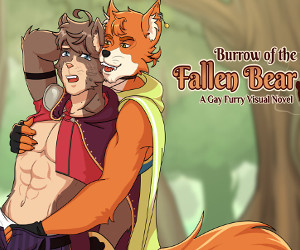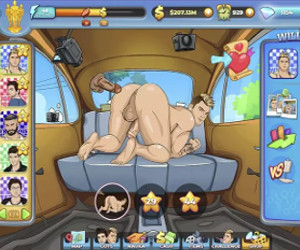Manga gay game
Despite the fact that Japan’s manga is usually divided by gender and age – shonen, for boys, and shojo, for girls – it offers representation for LGBT characters. Yaoi (known as BL in the West) and bara are smutty genres that depict homosexual relationships, though not all stories are necessarily pornographic.
Manga game gay
In this moody queer slice-of-life manga by Yuhki Kamatani (who self identifies as asexual and x-gender) we follow high school boy Tasuku Kaname who is terrified that he’s been outed. In desperation he rushes to a house in Onomichi, near Hiroshima, and finds that it’s actually a drop-in center for LGBTQ+ folks who have been struggling with issues similar to their own. The group of people that he meets in Onomichi help him to break down the emotional and mental walls that have been standing in his way, and find his own place as a LGBTQ+ person in an environment that is still not accepting.
Kamatani’s artwork is beautiful, filled with surreal imagery that conveys emotions better than words could ever do. Even mundane events like Aoba’s face being punched with Umiko’s airsoft pistol or Ko’s cheeks being inflated by Hifumi become meaningful due to how they are illustrated.
Boys’ love is a subgenre of shoujo manga (comics for girls) and the broader erotic media genre known as yei jei or tanbi, which features female-male romance. It is different from the shojo-manga (comics for women) subgenre and the larger erotic genre of media called yei jei. It’s also different from sexyei – a fetishistic representation of homosexuality, often created by females for female audiences.
Free manga gay games
When Butterfly Soup first released in 2017, it was a surprise hit for many queer gamers. Up until that point, no game had explored themes like homophobia and the intersections between race, gender, sexuality, and age.
This slice-of-life BL series follows Shiro Kakei, a serious lawyer who is always on the lookout for savings, and Kenji Yabuki, a gay hairdresser and cook. While Shiro is a serious and penny-pinching lawyer, Kenji is an openly gay hairdresser who loves to cook. Each episode is filled with charming humour, heartwarming stories and will make you laugh and cry.
The manga series was created by Gengoroh Tagame, who is known for creating erotic manga that explores gay men’s issues and subjects. In the 2010s, he began producing non-pornographic gay themes and subject material for mainstream readers.
The series’ uniqueness is the way it presents an older gay couple in a mainstream setting, while highlighting their domesticated relationship. The characters are well rounded and nuanced, and the lead actors handle both comedic and dramatic scenes with aplomb. It is one the best BL Dramas of all time, despite its simple premise. You will feel happy and uplifted when you watch it.
Romantic manga gay game
They’re both terrified when childhood friends Kazusa, Ayumu, and Ayumu begin dating. The two don’t want to admit it, and they are afraid of their parents. But when Ayumu Shiina, Ayusa’s senpai, reveals that Shiina is also gay, they realize that they’re not alone!
This manga about homosexual relationships is a heartfelt and realistic depiction of the struggles of LGBT+ characters. It’s also a good read for those looking to discover a new side of Japanese romance.
Boys’ Love (Japanese, Hepburn: Boizu Rabu) is a Japanese manga genre and other media that features homoerotic romances between male characters. It is usually created by females for a woman’s audience and differs from the broader yaoi sexy genre created by males for their audiences.
BL, despite being criticized by some for its latent fetishism of queer characters or even blatant fetishization, is still read and loved by many. Mangaka often cross genres to create media that suits their creative bent. This often results in a lack of discussion about the important issues facing the community, especially when it comes to non-consensual sexual assault and misgendered characters. Boy’s Love/BL, yuri-manga, and other manga that take place in sexy or alternative settings, do not address these topics.
Manga gay game mobile
Gone Home is an interactive first-person video game that allows the player to move through a home and interact with objects. The game’s interaction relies heavily on players exploring the house, and finding hidden notes. As such, it is a kind of queer archive that is structured around the idea of an archaeological uncanny (Moshenska 2006)-the quotidian is rendered strange through decay and horror tropes.
The ambiance is augmented by a moody score and a variety of Riot Grrl hits played on cassette tapes discovered in the house. This combination of sounds creates a evocative ambience that evokes tensions of a woman living in a patriarchal culture. This game features female characters who are not caricatures. That is rare for video games, where the majority of main roles are played mostly by men.
Even though there are many games that feature LGBTQ themes, it is difficult to find any without latent or obvious fetishism. The fact that more and more games focus on women, their lives and relationships rather than male escapism is encouraging. We can look to the work of developers such as Florence Smith Nicholls who, in her article on a queer game called Gone Home, argues that the way the game is structured “queers the domestic by making it unfamiliar”. This is a significant step in an industry where there is often a subtle or implicit gender bias.
Send the link to e-mail and play later...
 Gay Harem
Gay Harem VR Gay Games
VR Gay Games Try not to cum
Try not to cum Gay Game
Gay Game Nutaku Gay
Nutaku Gay 3D Gays
3D Gays



